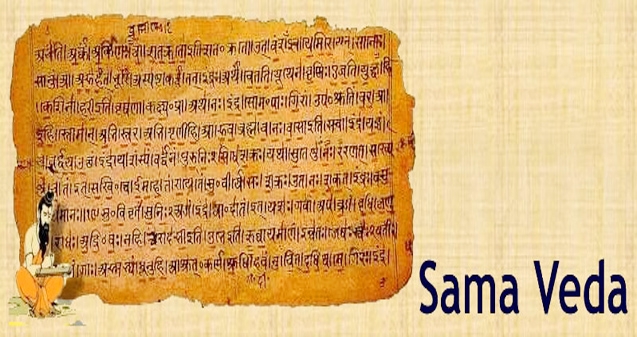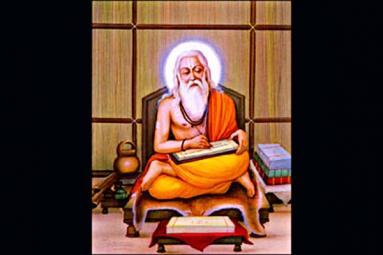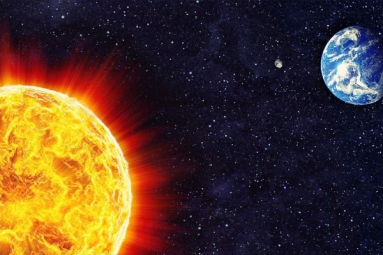
Sama Veda consists of a collection of hymns and sacred texts that are supposed to be sung instead of just being recited. In classical Sama Veda, the hymns are sung in praise of God and are basically religious and philosophicacl in nature. The hymns of Samaveda are derived from the Rig Veda and thus impart the lessons of the Rig Veda. It may be called an abridged version of the Rig Veda, in a melodious form. The melodious notes are called "Samans", hence the name Sama Veda. The Sama Veda contains around 1900 verses, 95% of which have been derived from the Rig Veda. The chanting notations are much more elaborate than Rig Veda and each syllable is sung in accordance to the seven swaras or musical notes. The scale is ascending, descending or a varied combination. Though the Vedas are considered to be the source of classical music, the concept of Raga, talas, etc. were developed much later. To know more about Sama Veda, continue reading this insightful article on it.
Contents Of Sama Veda
The musical annotation of the Sama Veda is what lends it a unique character. The Sama Veda is a representation of the rapture of devotion and spirituality. The essence of Sama Veda and Rig Veda has been summed up perfectly by the great Vedic scholar David Frawley. He says if Rig Veda is the word, Sama Veda is the song; if Rig Veda is the knowledge, Sama Veda is the realization; if Rig Veda is the wife, Sama Veda is the husband.
Composition: Out of many books or Samhitas of Sama Veda, documented as at least a 1000 Samhitas, we now only have three books. These three Samhitas are: Kouthomiya, Rahayaniya and Jaiminiya. In fact, Kouthomiya and Rahayaniya are almost indistinguishable in their content. The only difference exists in the way the hymns are arranged in their many stanzas. There are not many hymns in Jaiminiya as compared to Kouthomiya and Rahayaniya. In general Sama Veda is divided into two major parts: Archika (the verse collection) and Uttararchika (the second verse collection).Archika consists of five hundred and eighty five melodious hymns. These particular hymns are used at the time of a sacrifice. Uttararchika consists of total four hundred hymns and are supposed to be sung at the time of chief sacrifices. The chants is the verse collection is different from that of second verse collection in the sense that they are arranged according to the meter as well as according to the gods that it is addressed towards, but in Uttararchika the chants are assembled according to the chief sacrifices. Both these different parts of Sama Veda differ in the time of their origin; it is popularly believed that Archika was complied before Uttararchika. The hymns or chants in Archika are way more melodious than Uttararchika. Also, Uttararchika is essential to Archika because it completes it.
Archika also have two main parts: Gramageyajana, which is a book of chants meant to be recited by the villagers and Aranyagana, hymns which were meant to be sung exclusively in the forests. Aranyagana was exclusive to Gramageyajana because the chants in the former were thought to be very powerful and dangerous to be sung in a populated region, therefore their usage and chanting was restricted to the forests and uninhibited parts. Further to this, there were two other books called Uhagana and Uhyagana. Uhagana is a part of Gramageyagana and Uhyagana of Aranyagana.
There is a book called Samavidhana Brahmana, it is a ritual book full of magic charms and chants, which belongs to Sama Veda. It is exclusively dedicated to magic and occult.
Metre & Melody: The verses or the hymns in Sama Veda are arranged in the Gayatri meter. They are ordered in Pragatha stanzas, which are also quintessentially made up of Gayatri and Jagati line arrangement. The whole point of arranging these verses in Gayatri and Jagati line arrangements is to make them melodious for the purpose of singing. Sama Veda comprises of Sama verses. These Sama verses were taught orally in the form of songs and sometimes with the help of musical instruments. Later, these verses were taught in the form of musical notes. This means that the text was now drawn in the form it was supposed to be sung. It is presumed that from the very beginning every melody had a special name. These melodies are therefore mentioned in the ritual books by their particular name. These melodies were not just any simple musical compilations but these melodies or chants or hymns have symbolic meanings and mystical effects. Two of Sama Veda’s important melodies are used in Rig Veda: Brhat and Rathantara. These melodies date back to the times when partially religious songs were sung at the auspicious shortest and longest days of the year and other local and national religious festivities. There are some melodies that are as old as the songs that pre-Brahmanical occult- priests used to sing in the wild for their rites and rituals. It is said that Sama verses are the foundation of Indian music.
Contents Of Sama Veda
The musical annotation of the Sama Veda is what lends it a unique character. The Sama Veda is a representation of the rapture of devotion and spirituality. The essence of Sama Veda and Rig Veda has been summed up perfectly by the great Vedic scholar David Frawley. He says if Rig Veda is the word, Sama Veda is the song; if Rig Veda is the knowledge, Sama Veda is the realization; if Rig Veda is the wife, Sama Veda is the husband.
Composition: Out of many books or Samhitas of Sama Veda, documented as at least a 1000 Samhitas, we now only have three books. These three Samhitas are: Kouthomiya, Rahayaniya and Jaiminiya. In fact, Kouthomiya and Rahayaniya are almost indistinguishable in their content. The only difference exists in the way the hymns are arranged in their many stanzas. There are not many hymns in Jaiminiya as compared to Kouthomiya and Rahayaniya. In general Sama Veda is divided into two major parts: Archika (the verse collection) and Uttararchika (the second verse collection).Archika consists of five hundred and eighty five melodious hymns. These particular hymns are used at the time of a sacrifice. Uttararchika consists of total four hundred hymns and are supposed to be sung at the time of chief sacrifices. The chants is the verse collection is different from that of second verse collection in the sense that they are arranged according to the meter as well as according to the gods that it is addressed towards, but in Uttararchika the chants are assembled according to the chief sacrifices. Both these different parts of Sama Veda differ in the time of their origin; it is popularly believed that Archika was complied before Uttararchika. The hymns or chants in Archika are way more melodious than Uttararchika. Also, Uttararchika is essential to Archika because it completes it.
Archika also have two main parts: Gramageyajana, which is a book of chants meant to be recited by the villagers and Aranyagana, hymns which were meant to be sung exclusively in the forests. Aranyagana was exclusive to Gramageyajana because the chants in the former were thought to be very powerful and dangerous to be sung in a populated region, therefore their usage and chanting was restricted to the forests and uninhibited parts. Further to this, there were two other books called Uhagana and Uhyagana. Uhagana is a part of Gramageyagana and Uhyagana of Aranyagana.
There is a book called Samavidhana Brahmana, it is a ritual book full of magic charms and chants, which belongs to Sama Veda. It is exclusively dedicated to magic and occult.
Metre & Melody: The verses or the hymns in Sama Veda are arranged in the Gayatri meter. They are ordered in Pragatha stanzas, which are also quintessentially made up of Gayatri and Jagati line arrangement. The whole point of arranging these verses in Gayatri and Jagati line arrangements is to make them melodious for the purpose of singing. Sama Veda comprises of Sama verses. These Sama verses were taught orally in the form of songs and sometimes with the help of musical instruments. Later, these verses were taught in the form of musical notes. This means that the text was now drawn in the form it was supposed to be sung. It is presumed that from the very beginning every melody had a special name. These melodies are therefore mentioned in the ritual books by their particular name. These melodies were not just any simple musical compilations but these melodies or chants or hymns have symbolic meanings and mystical effects. Two of Sama Veda’s important melodies are used in Rig Veda: Brhat and Rathantara. These melodies date back to the times when partially religious songs were sung at the auspicious shortest and longest days of the year and other local and national religious festivities. There are some melodies that are as old as the songs that pre-Brahmanical occult- priests used to sing in the wild for their rites and rituals. It is said that Sama verses are the foundation of Indian music.
source : iloveindia











